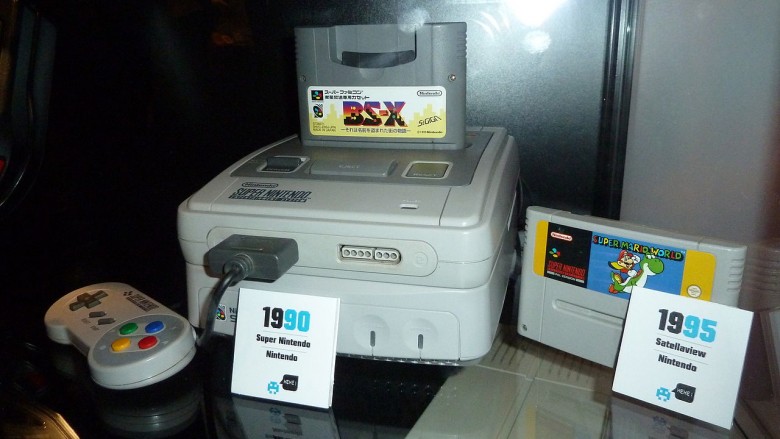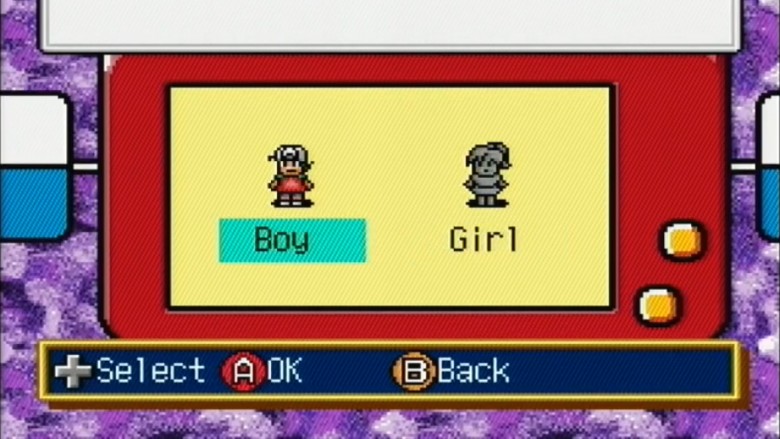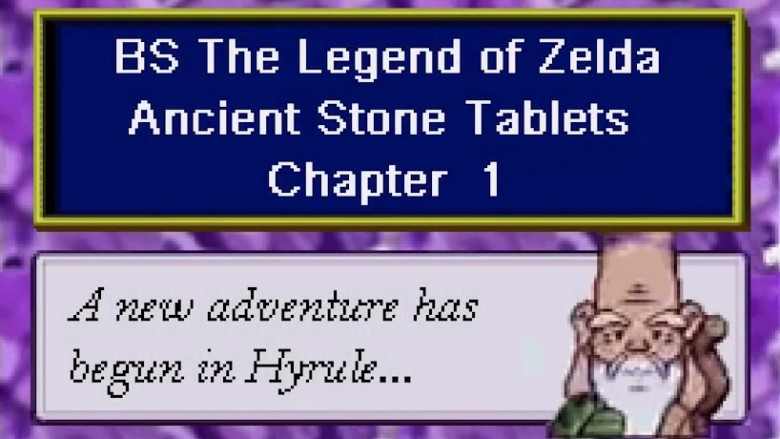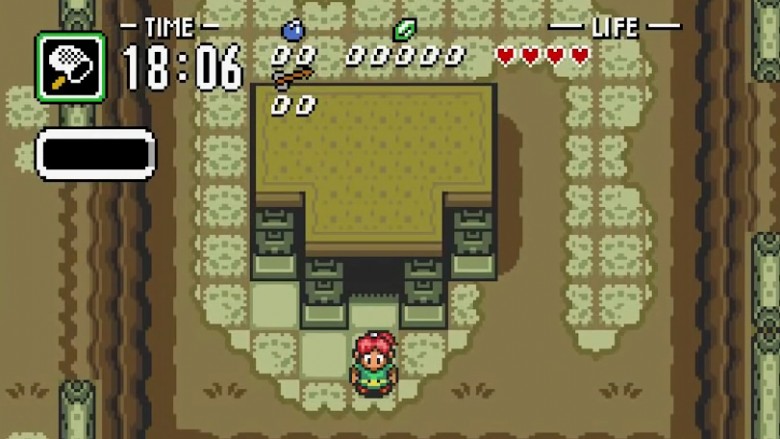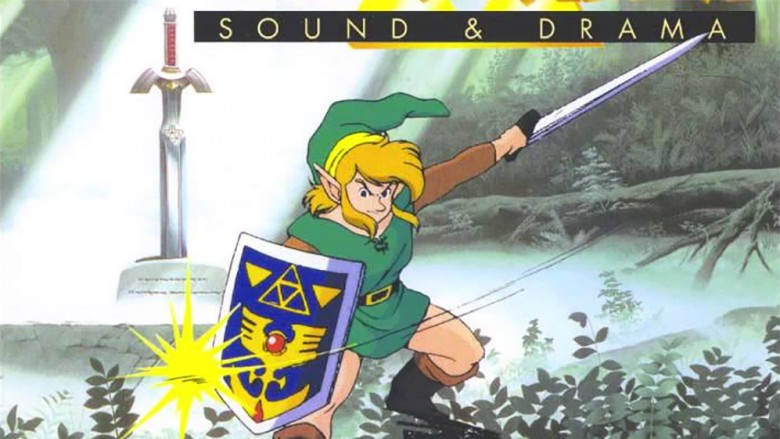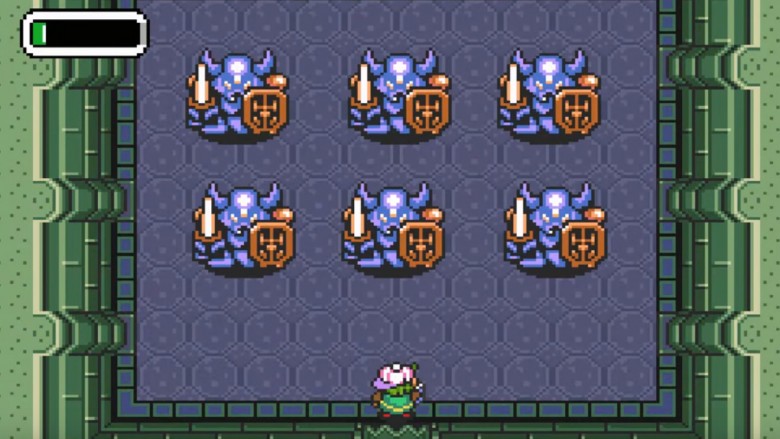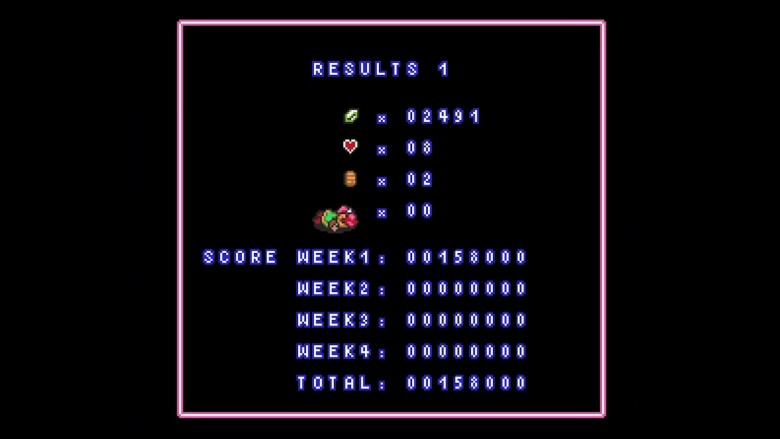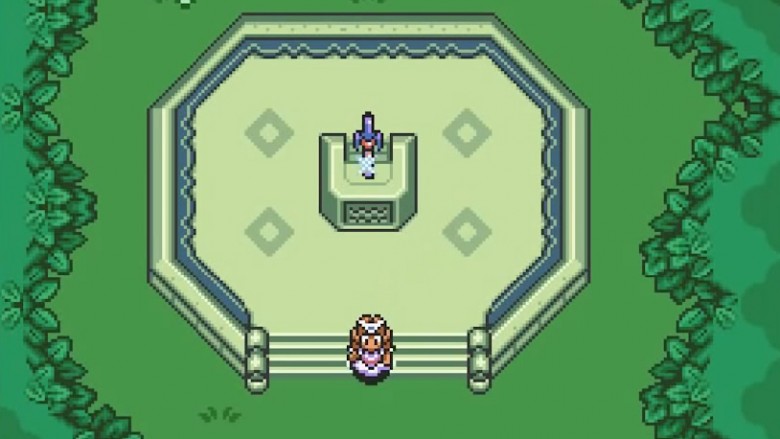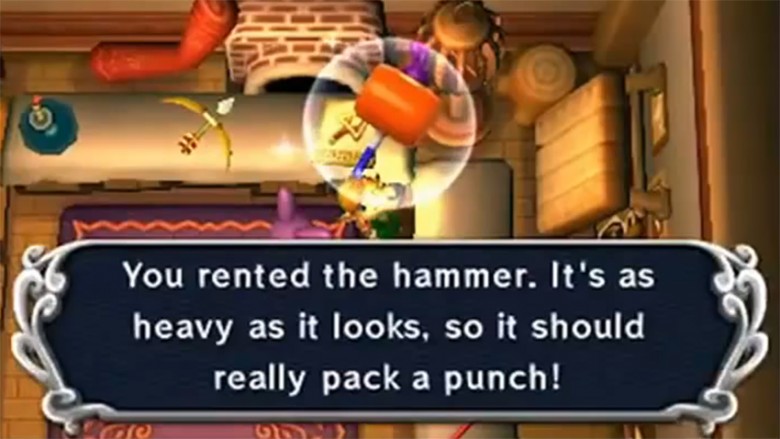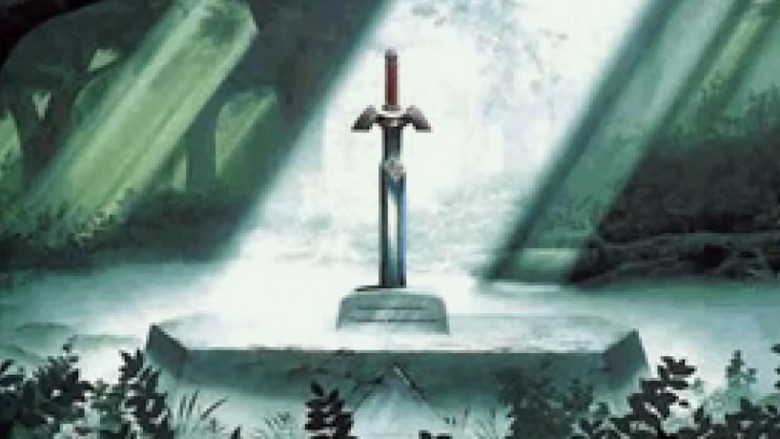The Lost Zelda Game Most People Never Got To Play
Unless you're the hardest of the hardcore Zelda fans, you've probably never even heard of BS The Legend of Zelda: Ancient Stone Tablets, let alone actually played it. There's a good reason for that. Not only was Ancient Stone Tablets exclusive to an odd, Japan-only Super Famicom peripheral called the Satellaview, but—much like a television show—it was broken into parts and only broadcast on certain days. If you weren't sitting in front of a television at a very specific time in 1997 Japan, chances are you missed it.
That's too bad. At first glance, BS The Legend of Zelda: Ancient Stone Tablets isn't the most original-looking Zelda game—it's basically a remix of The Legend of Zelda: A Link to the Past with a new story grafted on top—but thanks to Satellaview's unique hardware, Ancient Stone Tablets let Nintendo get weird—and weird is what Nintendo does best. As a game, BS The Legend of Zelda: Ancient Stone Tablets is full of interesting ideas. As a piece of Zelda's legacy, this game is crucial, fascinating, and sadly overlooked.
Let's change that.
Introducing the Satellaview
Before Steam and the Nintendo eShop—and, really, widespread internet access of any kind—Nintendo of Japan released a peripheral called the Satellaview for the Super Famicom (the Japanese name for the Super Nintendo), which could download games and other content via a satellite radio service known as St.GIGA.
Every game was "broadcast" on the system at specific times, meaning that not only was the lineup constantly changing, but anyone who wanted to play a certain game had to check the Satellaview's schedule and make sure to log on while the game was still available. Because they were delivered via satellite, most Satellaview games had a "BS" prefix, which stands for "Broadcast Satellite."
After downloading a game, users could store it on a rewritable memory packs, which were also used to save players' progress—which was key, given that many Satellaview games were released in multiple parts. Most of the Satellaview games were remixes of existing Famicom and Super Famicom titles. BS F-Zero Grand Prix and its sequel, for example, played like the original F-Zero, but added some new tracks and vehicles to the game. BS Super Mario USA Power Challenge is a remix of America's Super Mario Bros. 2 (you know, the one with all the turnips), with only Mario available at the beginning of the game and some new collectibles hidden among the game's levels.
BS The Legend of Zelda: Ancient Stone Tablets isn't the only Zelda game that appeared on the Satellaview. BS The Legend of Zelda and BS The Legend of Zelda Map 2 are basically remakes of the original The Legend of Zelda, but with 16-bit graphics, some user interface improvements, and new dungeon layouts.
Move over, Link, there's a new hero in town
In true Nintendo fashion, the Satellaview had a pretty quirky user interface. Instead of a traditional menu-driven system, the Satellaview came with a special "game" called BS-X: The Story of The Town Whose Name Was Stolen. After booting up the Satellaview, the system asked users to choose their gender and to create a special avatar, kind of like an early version of Nintendo's Miis. After that was finished, players were dropped into a virtual town—presumably the one whose name was stolen—and could read the latest news on the town bulletin board, or download games and other digital content by entering one of the city's four buildings.
The Story of the Town Whose Name Was Stolen isn't really a proper game—reportedly, there's no way to win or lose, although it did have a loose story—but it controlled like one, and did cross over into other Satellaview titles. In the case of BS The Legend of Zelda: Ancient Stone Tablets, that meant replacing Link, Zelda's traditional hero, with the user-made avatars, who were known in-game as the Heroes of Light.
BS The Legend of Zelda: Ancient Stone Tablets even contains an in-story reason as to why the game uses the Satellaview characters, and not Link. apparently, Link left Hyrule after A Link to the Past, leading Zelda to search for a new champion. When the Hero of Light mysteriously arrives, he (or she) reminds Zelda of Link—in order to make Ancient Stone Tablets more Zelda-y, the Hero wears Link's clothes—and she recruits the Hero to her cause. Later, players learn that Ganon summoned the Hero to Hyrule in hopes of taking his or her power, but it doesn't work out quite like Ganon expected—like A Link to the Past, Ancient Stone Tablets ends with the Hero putting an arrow in the villain's head.
An adventure in four parts
With the rise of digital distribution and post-launch DLC, companies like Telltale, BioWare, and IO Interactive, which makes Hitman, have turned episodic games into something of an art form, but back in the '90s, that seemed crazy, especially on consoles. After all, who wanted to walk into Software Etc. or Babbage's and leave with only the first part of a game?
But on the Satellaview, episodic gaming was the norm, and BS The Legend of Zelda: Ancient Stone Tablets was no exception. From March 30 through April 20, 1997, Nintendo broadcast four episodes of Ancient Stone Tablets over St.GIGA. Every week, Ancient Stone Tablets gave players different dungeons to explore and different items to collect.
If you missed an episode, you couldn't go back and replay it, either. While Ancient Stone Tablets uses the same overworld as A Link to the Past, every week, certain sections were gated off (often, in true Zelda fashion, by using objects that players couldn't move, thanks to some missing gear), keeping the map smaller and more focused. If you missed one week's installment, you could score the important loot by visiting the dungeon's entrance, where a thief would give you the items you missed. However, if you took that route, your final score wouldn't be as high. Besides, having treasure handed to you isn't nearly as fun as diving into one of Ancient Stone Tablets' dungeons and making discoveries for yourself.
Saving Hyrule one hour at a time
St.GIGA didn't just distribute games. It was actually a fully-fledged radio and video service—the Satellaview support was just a bonus. As such, Satellaview games were only broadcast for a few hours a day. While users could download some Satellaview games to play later, others, including BS The Legend of Zelda: Ancient Stone Tablets, were only playable during their specified broadcast windows.
It basically worked like television back in the days before DVRs and streaming video services. Every week, BS The Legend of Zelda: Ancient Stone Tablets came on at the same time, and aired for an hour—which, excluding the episode's beginning and ending cinematics, resulted in about 50 minutes of playtime. If you didn't catch that week's episode when it aired, you'd have to wait for a rerun (which happened occasionally), or just live out the rest of your life not knowing exactly what happened that week.
That sounds restrictive, but the predictable timeframe actually let Nintendo do some pretty cool stuff. For example...
A journey full of sound and drama
Super Famicom cartridges didn't have enough storage space to support advanced multimedia features like voice acting, pre-recorded music, or video. Neither did the Satellaview memory packs. However, because Nintendo knew exactly when everyone would be playing BS The Legend of Zelda: Ancient Stone Tablets, they could take advantage of St.GIGA's streaming technology to add voice acting and high-quality music to the game.
Nintendo called games like BS The Legend of Zelda: Ancient Stone Tablets SoundLink games, and used the technology to execute in some pretty innovative ways. The music itself came from the Legend of Zelda: Sound and Drama soundtrack, which contained tracks from The Legend of Zelda: A Link to the Past. Meanwhile, voice actors ramped up the drama during cutscenes and served as narrators during play, giving players tips and alerting them to special events.
For example, throughout Ancient Stone Tablets' first episode, a fortune teller explains how players can catch fairies with their nets, a soldier alerts players that the potion shop has some new wares, and the sage Aginah explains the game's backstory.
Constant surprises
Using BS The Legend of Zelda: Ancient Stone Tablets' strict schedule and SoundLink technology, Nintendo introduced random, limited-time events into all four Ancient Stone Tablets episodes, many of which changed the way the game played. About 20 minutes into the first episode, a thunderstorm hits, making bombs ineffective until the rain clears ten minutes later. About two-thirds of the way through, Princess Zelda is attacked by monsters, opening up an optional side-quest. Other special events in the first episode include a magic spell that unlocks unlimited arrows and a mysterious peddler who sets up shop near Hyrule's temple.
That might not sound like a big deal—Majora's Mask changes based on the time of day, and The Breath of the Wild has dynamic weather patterns too, which keep Link from using metal weapons in thunderstorms, or make it harder to climb on slick, wet surfaces. Still, Ancient Stone Tablets marked the first time world-changing events had been seen in a Zelda game, and it all worked because of the Satellaview technology.
Because Nintendo knew roughly where the average player would be at every moment, the developer could tailor these "random" events to help (or hurt) the player as they faced specific challenges. Meanwhile, using the SoundLink technology, Nintendo could relay messages about special events to the player using voice acting, explaining what was happening, what that meant in terms of gameplay, and where to find limited-time content without disrupting the flow of the game.
Real-life treasures
Most Zelda games (and most video games in general, really) are about the journey, not the destination. You don't really get much out of beating them, other than an ending cinematic and a warm fuzzy feeling of pride. BS The Legend of Zelda: Ancient Stone Tablets was different. Allegedly—and, admittedly, this is a part of the game that's not incredibly well-documented—you could earn real-life prizes including phonecards and Satellaview cartridges if you had one of the week's highest scores.
Oh, that's right: unlike other Zelda games, BS The Legend of Zelda: Ancient Stone Tablets tallied up points as you played, and gave you a score at the end of each session. Among other objectives, every week players had to track down two stone tablets. For every minute that passes before both tablets are found, players lose 500 points, so it's important to find those items as soon as possible if you want to maximize your score.
Retrieving a tablet earns 40,000 points (minus the time penalty), while other actions' payouts ranges from 500 (opening a chest) to 5,000 (a heart container) to 10,000 for finding "the mole," a hidden character who appeared on a different spot on the map each week. These days, people aren't sure how players submitted their scores to Nintendo in order to claim their loot, although many agree that sending Nintendo a code via snail-mail is probably the most likely solution.
One and you're done
Some Satellaview games could be played repeatedly, as long as you didn't erase it from the cartridge you saved it on. BS The Legend of Zelda: Ancient Stone Tablets wasn't one of them. Because of the SoundLink integration, the game simply wouldn't work if you tried to boot it up outside of the broadcast window.
In fact, if you missed BS The Legend of Zelda: Ancient Stone Tablets the first time, the only way to replay it was to wait for a rerun, which happened at least three times. Interestingly, it seems as if the game was changed a little bit every time. Video game historians who've examined recordings of playthroughs in order to piece together how the game works note that the location of the mole—who gives players extra points and a room full of rupees when he's discovered—changed during different broadcast runs.
Oddly, it doesn't look like any code was actually altered in order to move the mole around. Hackers note that code to change the mole's location between broadcasts was actually embedded in the game itself—all Nintendo needed to do to create a fresh experience was change the game's settings. That means that Nintendo was planning ahead when it developed Ancient Stone Tablets, knew that it would be broadcasting the game multiple times, and decided to make it easy to shake things up for future playthroughs.
A lost but influential legacy
According to the Hyrule Historia, the definitive tome of Zelda history, BS The Legend of Zelda: Ancient Stone Tablets is one of the few The Legend of Zelda Games published by Nintendo that aren't officially part of the canon (spinoffs like Link's Crossbow Training and the Satellaview Legend of Zelda remakes didn't make the cut either). Despite the omission, however, a number of ideas that first appeared in Ancient Stone Tablets have found their way into other, more mainstream Zelda titles.
In Ancient Stone Tablets, players can rent gear they don't have in order to master dungeons, a feature that was likely added in order to help out players who missed an episode or two. This idea returned years later in The Legend of Zelda: A Link Between Worlds, in which players can rent items in order to tackle dungeons out of order. Ancient Stone Tablets is the first game in which Princess Zelda is shown using psychic abilities—a major plot point in later installments—and is the first Zelda game with spoken dialogue, which wouldn't happen again until Nintendo released Breath of the Wild.
Ancient Stone Tablets' biggest addition to the Zelda formula, however, was undoubtedly the timed events, which Nintendo used to great effect in both Majora's Mask and Breath of the Wild. In both of those games, the world changes based on the in-game time, with some characters and quests only appearing at pre-set times. That's basically how Ancient Stone Tablets works, too, and it goes a long way towards making Hyrule feel like less of a product, and more like a living, evolving place.
A labor of love
If it hasn't been clear so far, BS The Legend of Zelda: Ancient Stone Tablets had a lot of moving pieces, which has made it incredibly difficult for historians to properly preserve the game. For one, it requires an emulator to play, given that the Satellaview system shut down entirely back in 2000. In order to get the game's code, fans had to locate Satellaview disks that still worked and had all four episodes of the game intact—a task that proved to be pretty difficult, given that the Satellaview cartridges were designed to be re-written with new content.
Securing copies of the game isn't enough, however. Thanks to all the streaming content, including the game's intros and all of the SoundLink material, significant portions of the game were still missing. Thankfully, fans eventually uncovered VHS recordings of the game's original broadcast, filling in a number of the blanks, and allowing fans to create a copy of the game that's as close as possible to the real thing.
But that's not all. As a Japanese-only release, none of the game is in English, making it hard to enjoy for western players. Thankfully, Zelda fans are a dedicated bunch, and a full English translation—including re-recorded dialogue to replace the SoundLink voiceovers—appeared online last fall. If you don't mind dirtying your hands with emulators, you can head over to the BS Zelda fanpage right now and play Ancient Stone Tablets from start to finish.
Is BS The Legend of Zelda: Ancient Stone Tablets as good as Zelda games like A Link to the Past, Ocarina of Time, or Breath of the Wild? Not really. Is it a fun, interesting peek into The Legend of Zelda's storied history? Absolutely. Thanks to the game's episodic format, you can beat the whole thing in an afternoon, and for Zelda fans—especially those who think they've seen everything Hyrule has to offer—there are definitely worse ways to spend three or four hours (Link: The Faces of Evil, we're looking at you).


